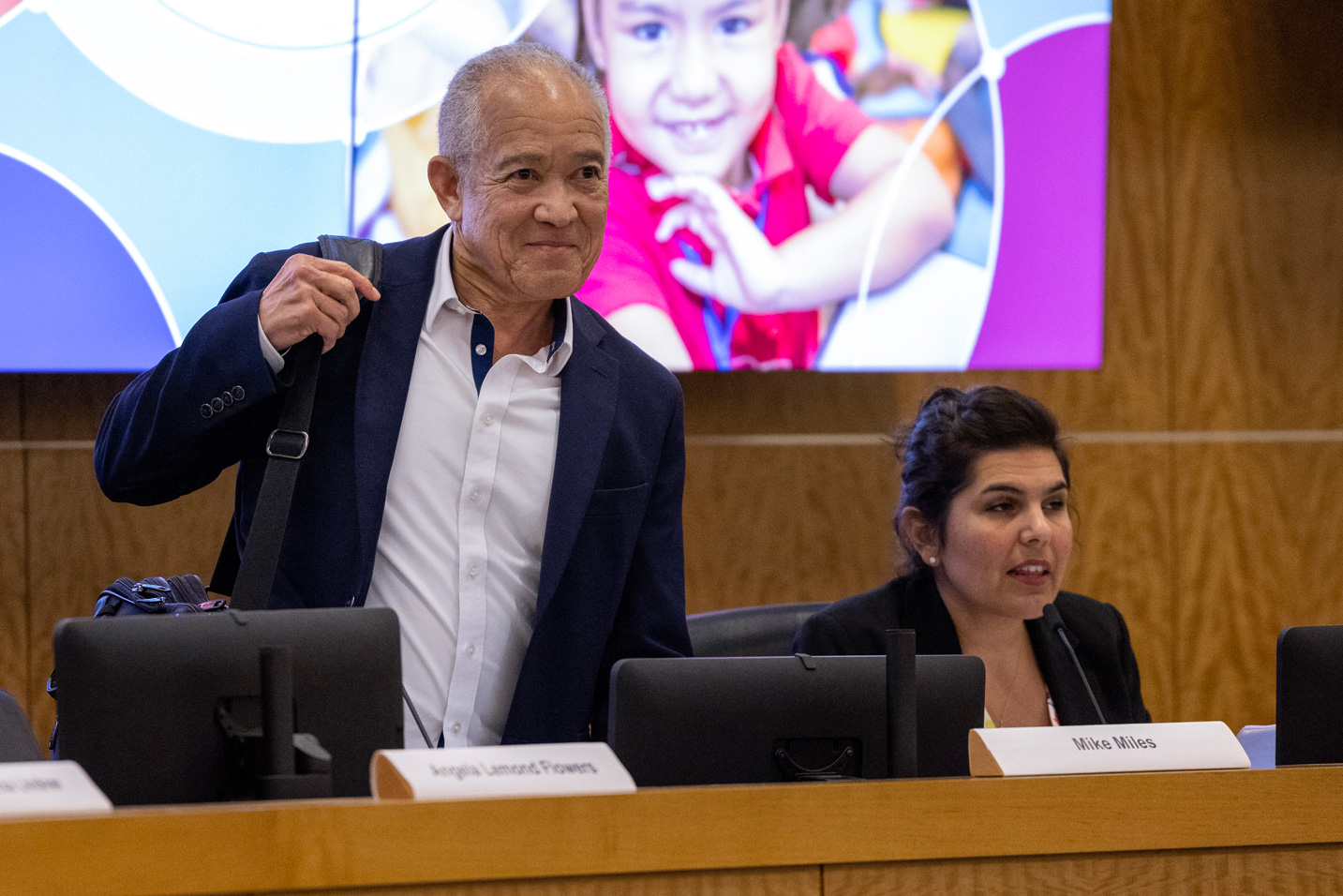|
Getting your Trinity Audio player ready...
|
Newly appointed Houston ISD superintendent Mike Miles has promised major changes are coming to Texas’ largest school district — with nearly 30 campuses targeted for immediate overhaul.
Just two weeks into the job, Miles has announced plans to “reconstitute” 25 HISD schools on the city’s northeast side, along with three more campuses in other parts of the district. Those schools will look dramatically different next year, with job responsibilities re-engineered and educators forced to reapply for their roles, among other changes.
Miles said the shuffle aims to place the best teachers in front of the historically lowest-performing kids, in an environment where educators can focus solely on providing high-quality instruction.
It’s a familiar approach for Miles, who employed similar strategies when promoting change as superintendent of Dallas Independent School District and the CEO of a charter school network in Colorado.
The Texas Education Agency appointed Miles as HISD’s new superintendent and replaced the district’s school board at the start of the month. The controversial move was part of sweeping sanctions tied to chronically poor scores at Wheatley High School.
Many parents and community members are distrustful of HISD’s new leaders, who replaced the district’s elected school board and the old board’s chosen superintendent.
Dozens of community members protested last week at the appointed board’s first public meeting, criticizing the takeover as undemocratic and blasting Miles’ recently unveiled plans for schools that almost exclusively serve Black and Hispanic students. Families also have voiced concerns about the board’s makeup and its ability to confront issues unique to impoverished communities, with seven of nine members residing in affluent neighborhoods.
Here’s what we know so far about Miles’ turnaround plans, how they compare to his previous efforts and what his past can tell us about the reshaping of HISD schools.
How will Miles’ strategy impact staffing in HISD?
The 28 schools undergoing changes comprise the “New Education System,” or NES, a term coined by Miles. The NES includes every elementary, middle and high school in three feeder patterns: Kashmere, North Forest and Wheatley. Three other campuses Miles deemed “high-need” — Highland Heights Elementary School, Henry Middle School and Sugar Grove Academy — will be part of the NES.
Miles’ plans to make educators re-apply for their jobs have been well-publicized, but his ideas go much further than that.
To start, Miles plans to pay teachers in NES schools much more than before, in an effort to attract and retain top talent.
Miles has only released salaries for middle school NES teachers to date — he’s expected to announce pay plans for elementary and high school teachers in the coming weeks — but the available data shows the commitment to higher pay.
Middle school reading, English Language Arts, math and science teachers will earn minimum salaries of $81,000 to $86,000, with the maximum ranging from $99,000 to $111,000. Social studies and electives teachers will start at $74,000 and $65,000 respectively.
Teacher salaries typically began at $61,500 last school year and maxed out near $80,000, according to HISD’s compensation manual. Educators teaching core subjects, such as math and reading, did not make significantly more than their peers.
Teachers placed inside NES classrooms also will receive various financial incentives, including a $10,000 bonus and $2,000 stipend for summer professional development.
“The money will be good, but there's another side of that,” Miles said. “That is high-performance culture, high quality of instruction and accountability. Not all teachers will want to do that and not all teachers can do that. So that's why we're interviewing everybody. We're going to have a performance interview, and those we think can do it are the ones we'll hire.”
Miles’ staffing plans have drawn criticism from some parents and community leaders, who worry that the changes will break important relationships between students and teachers.

Elected HISD trustee Kathy Blueford-Daniels, who technically remains in office but had all of her powers stripped by the state, questioned how the “best-performing” teachers will be selected. To her, it’s a subjective title that will put teachers under a microscope and breed dishonesty in reporting test scores, for fear of being critiqued harshly.
Once teachers are selected, Blueford-Daniels wonders how well-positioned the chosen teachers will be to serve students in high-poverty neighborhoods. A teacher from one side of town can be high-performing but lack understanding of the obstacles students face in struggling communities, she said.
“It'd be hard for them to grasp … a child (who) can’t learn after being up half the night, or watching their siblings, or going to bed hungry,” Blueford-Daniels said. “We say these things, but it's real in these areas. It's not just a way of promoting or minimizing a child's learning ability in certain schools.”
How will the classroom look different in reconstituted schools?
Miles said he wants to restructure the role of teachers by taking routine tasks off their plate, such as making copies, completing lesson plans and grading papers. Teachers should be able to come in and “teach like champions,” he said.
Miles likened his vision for NES classrooms to that of a surgical procedure: “(Doctors) don't prep the room, they don't pick up the materials, they don't take the blood pressure, they don't get the equipment. They just come in and have somebody put their gloves on, and then they do their surgery.”
HISD officials said some teacher responsibilities will be shifted to administrators, teacher apprentices and learning coaches.
Curriculum and lesson plans will be standardized in NES schools, with the district’s curriculum department determining the lessons taught and the pace of delivery.
HISD officials have also said magnet programs and magnet-related jobs will be “evaluated on a case-by-case basis.”
Any cuts could free up millions of dollars to spend on other initiatives, but students could lose access to STEM, dual language, fine arts and other magnet programs. Twelve of the 28 NES campuses were scheduled to receive dedicated funding for magnet programs last school year totaling about $3 million, according to HISD budget documents.
HISD’s appointed school board is scheduled on June 22 to vote on suspending HISD’s policies related to magnet schools “to allow the leadership team the necessary discretion to implement changes when necessary at New Education System schools,” according to board documents. District officials do not plan to change any magnet programs outside of the NES campuses.
Higher teacher salaries will be supplemented, in part, by cutting central office positions and vendors in schools to combat what Miles calls “central office inefficiencies.” Miles has not yet outlined which jobs or vendors will be eliminated.
The NES system will not impact class size, assuming the student population stays roughly the same. There might be “minor” changes to breakfast routines to increase time spent in the classroom, according to HISD.
What have Miles’ past turnaround efforts looked like?
Miles also laid the foundation to replace teachers in large numbers, boost educator pay and restructure classrooms in low-rated schools in Dallas, where he served as superintendent from 2012 to 2015.

Miles’ tenure ended before the full implementation of the initiative, known as Accelerating Campus Excellence, or ACE. Still, Dallas leaders ultimately carried out the ACE program he envisioned.
Hundreds of thousands of dollars were dedicated to ACE schools, which saw nearly the entire teaching staff of several schools replaced with educators who ranked high under the district’s evaluation system. Educators were offered bonuses ranging from $6,000 to $12,000, depending on their performance rating. School days were temporarily lengthened and students were offered extra tutoring and student support.
ACE schools saw dramatic improvement under the model: test scores rose at nearly all campuses, while discipline rates plummeted.
Dallas officials expanded the ACE program, but to do so, that required pulling back some funding dedicated to the initial group of schools. Some of those campuses maintained their gains, while others saw a decline in performance.
“It’s not some silver bullet program that you can just say, ‘We’re going to do ACE,’ and it will be successful,” Garrett Landry, who helped school districts create similar turnaround initiatives, told the Houston Chronicle in early 2020. “It’s hard, hard work. It’s a lot of intentionality and fidelity in implementation. And I think, without question, schools need additional funding.”
Dallas returned funding to ACE campuses and added more schools to the fold, bringing the total to 22, after passing a local tax increase and receiving more state funding.
Nineteen of those campuses scored B or C grades under the state’s academic accountability system in 2021-22, while three would have received D or F grades. (The state didn’t officially rate campuses scoring at the D or F level due to the lingering impact of the pandemic.)
After resigning from DISD, Miles led Third Future Schools, an organization that operates seven campuses in Colorado and Texas, including the Austin, Ector County and Midland independent school districts.
To date, only two of Third Future’s Texas campuses — Sam Houston Collegiate Preparatory Elementary School and Ector College Prep Middle School, both located in the Permian Basin area — have received academic accountability ratings from the state. Both campuses scored B ratings in 2022 under Third Future after receiving failing grades in 2019, when the local district ran the schools. (Texas campuses weren’t rated in 2020 or 2021 due to the pandemic.)
How does his plan for HISD differ?
By far, this will be Miles’ largest, most ambitious turnaround plan of his career.
With Dallas and Third Future, Miles started by tackling several schools at one time, spending multiple months devising plans. In HISD, he’ll overhaul nearly 30 campuses over a single summer. The incentives for moving to an NES school will also be larger than in Dallas.
Miles’ plans also include five middle schools and three high schools — differing from previous efforts. The list of 22 Dallas ISD schools that have used the ACE model includes only three middle schools and no high schools. Third Future has not taken on a high school.
Previous turnaround initiatives also have not covered entire feeder patterns or some highly rated campuses, while HISD’s does.
“It’s a different context and different things have to be done here,” Miles said in a late May interview with the Abdelraoufsinno. “But many of the large, urban strategies and practices are the same.”


